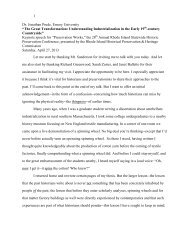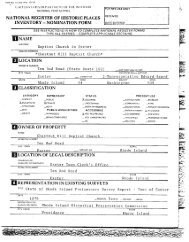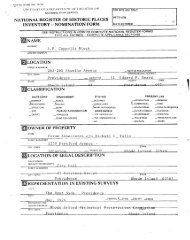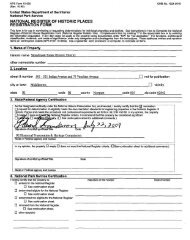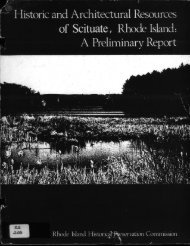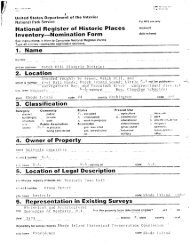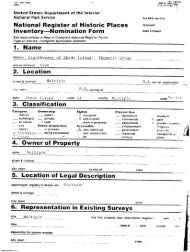National Park Service - Rhode Island Historical Preservation ...
National Park Service - Rhode Island Historical Preservation ...
National Park Service - Rhode Island Historical Preservation ...
Create successful ePaper yourself
Turn your PDF publications into a flip-book with our unique Google optimized e-Paper software.
0MB NO- 1024-0018<br />
NPS Form 10-900-i - - En,- 10-31-84<br />
3-82<br />
United States Department of the Interior<br />
<strong>National</strong> <strong>Park</strong> <strong>Service</strong><br />
<strong>National</strong> Register of Historic Places<br />
Inventory-Nomination Form - -<br />
Continuation sheet 17<br />
Item number 7<br />
Page 1 $<br />
37A -<br />
Mill Office 1881:<br />
This small yet monumental brick-trimmed stone building<br />
terminates the vista north up Kingstown Road toward the center of<br />
the village. Its location and elaboration herald the fact that<br />
it was the nerve center of Peace Dale. The 1-1/2-story structure<br />
has a high basement. Its stone walls terminate in an extremely -<br />
heavy, corbelled brick cornice; there are brick panels below each<br />
window. The windows have stained glass transoms. The high hip<br />
roof is accented by gabled dormers and enriched at the ridge by a<br />
massive chimney stack in brick corbelled out at the top above a<br />
row of four small blind and open arches. Known as the "counting<br />
house" within the Hazard family, this striking, more-or-less<br />
Queen Anne style building is attributed to Rowland Hazard II,<br />
whose office was here see photos #1 and #2. C<br />
373<br />
- The original Peace Dale Stone Woolens Mill 1847 et seq.:<br />
The extant structure is a remnant of the 1847 mill building<br />
preserved for its historic interest by the Hazard family when the<br />
plant was greatly enlarged and converted for production of<br />
worsted goods. Of the 1847 factory what survives is the 2-1/2story,<br />
stepped-end-gable, 3-story, and belfry. The Greek Revival<br />
style belfry is frame. From a panelled base section housing the<br />
bell-there rises a delicate open framework forming a short spire<br />
crowned by a weathervane in the form of a shuttle. The main body -<br />
of the 1847 mill was replaced by a 1- and 2-story flat roofed<br />
structure which in truth is but an appendage to a large 2-story<br />
wing 37C. see photo #2. C<br />
37C -<br />
Wing added to the 1847 Mill 1847 et seq.:<br />
The 2-story stone wing has a very low gable roof. Its end<br />
wall on Columbia Street is incorporated directly into the<br />
stonework of the relic-like remnant of the 1847 mill 373. The<br />
long west wall of this mill as well as the east wall of the<br />
reworked 1847 mill have what in effect are "ribbon windows" -continuous<br />
banks of 12/12 sash with narrow, metal-clad posts<br />
between. Most extant glazing is heavy, ribbed diffusion glass<br />
see photo #2. C<br />
37D<br />
Laboratory and Store House c. 1875:<br />
Small, 2-story stone structure with low pitched roof, wide<br />
eaves. The lower story has few openings; there are S windows on<br />
each side in the second story. Now used as offices, there is a







